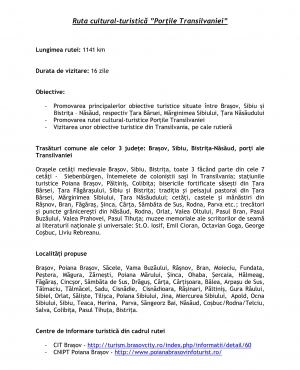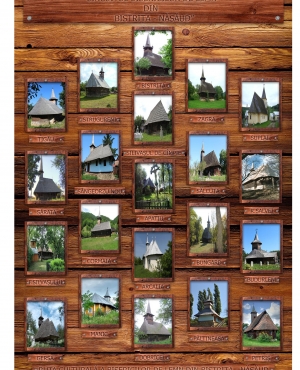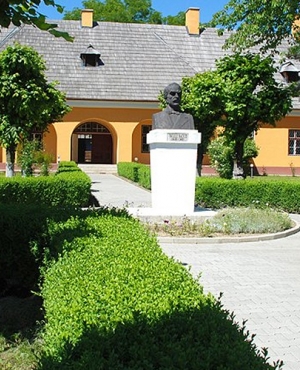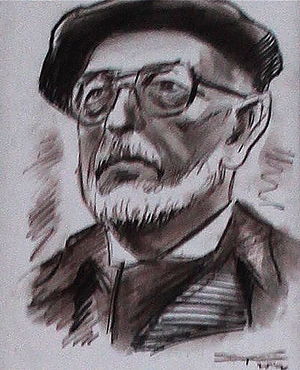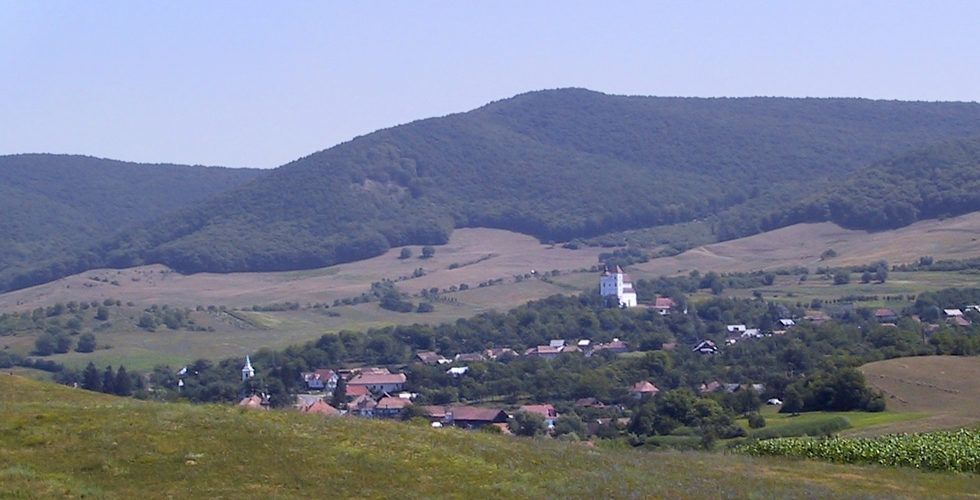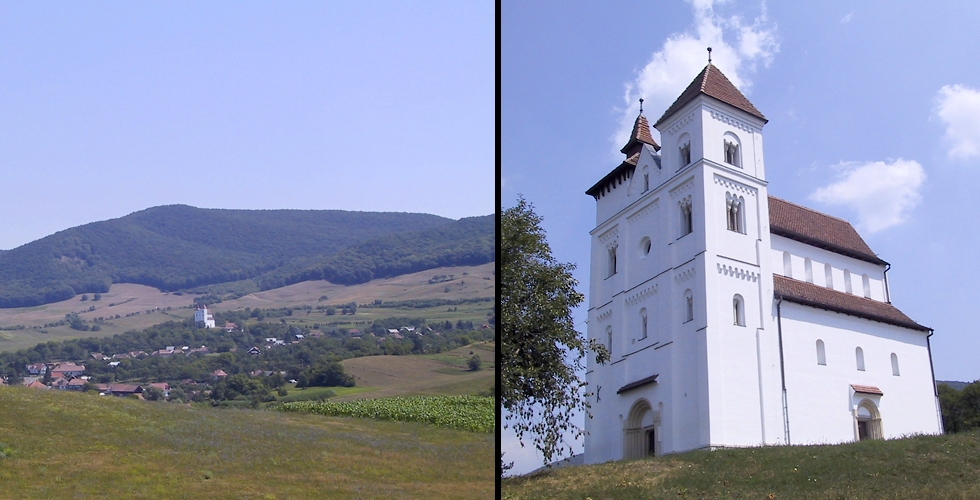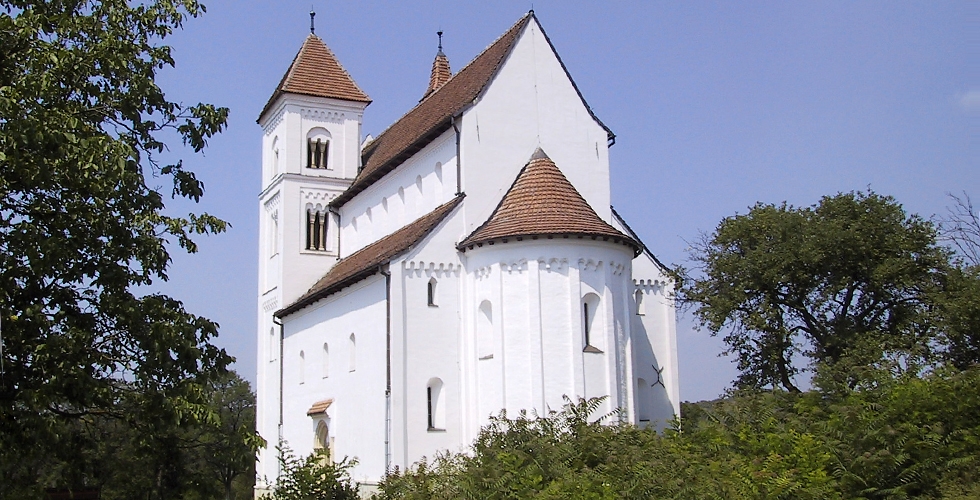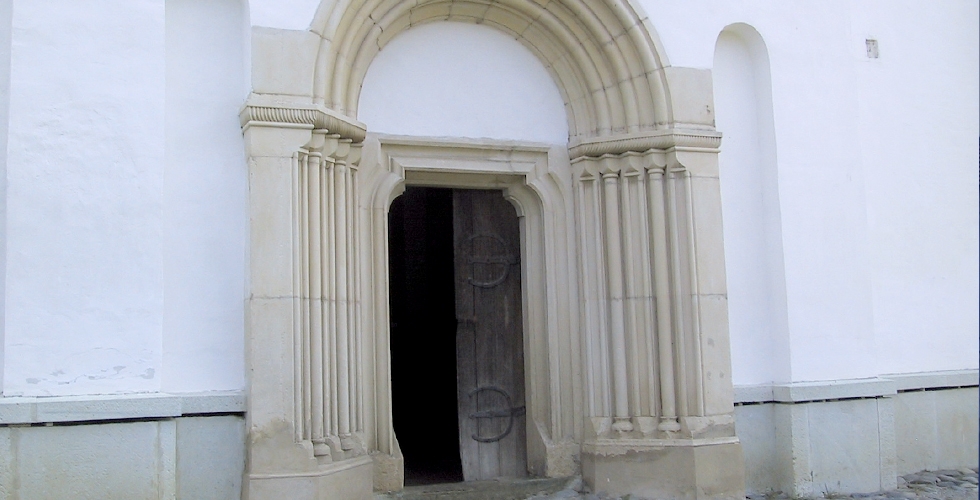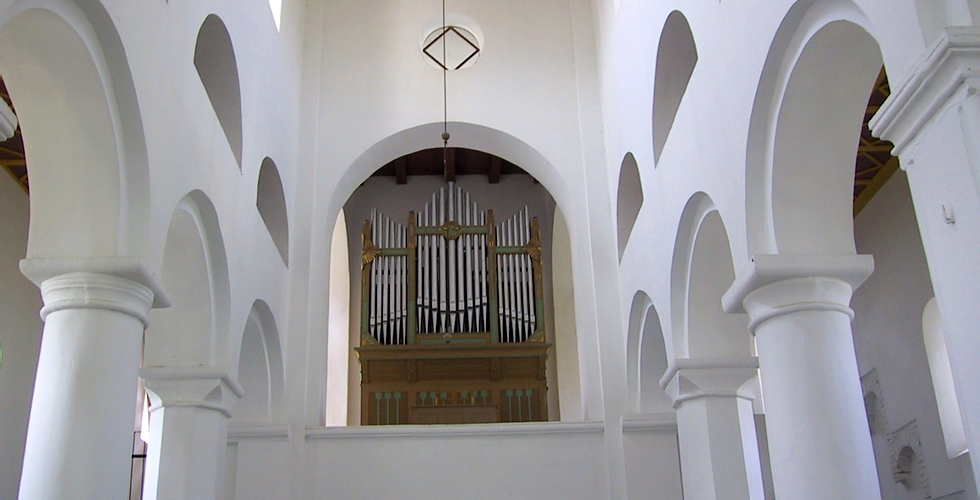Intr-un muzeu daca dorim sa venim in intampinarea dorintelor beneficiarilor de diverse tipuri este important sa tine
Evangelic Church Herina
You are here
Evangelic Church Herina
The traveler reaching northern Transylvania is welcomed, on the highlands in the eastern side of Herina, by an imposing castle-like monument. It is the evangelic church of the village, one of the oldest and stylistically most unitary architectural monuments in Romania, and an important mark of medieval architecture in Central Europe. The building of such a construction at the eastern border of the Hungarian Kingdom, within which Transylvania was already integrated at the moment the church has been built, finds its explanation in the political and administrative evolution of the region, which, during 12th – 13th centuries was made up of a multitude of territories with different patrimonial and legal regimes, some of them being linked to the Royal Lands, some others to laic and religious noblemen.
The firsts, inhabited by colonists, beneficiaries of privileges, will build up the Saxon District of Bistrita (Nösnerland), the others, situated on the territory of the shires will remain under the rule of several powerful noble families: Kökényes-Renold, Kacsics, Apa, Bethlen. Herina was situated on the territory of the shire Dăbâca, being one of the feudalities under the rule of the family Kacsics. The first documentary mention of the settlement dates back in 1246 in a document of the King Bela the 4th, who took out of the jurisdiction of the Transylvanian Voyevode „and not to be forced to obey somebody else’s judgment except for their bishop or judge” the inhabitants of several feudalities belonging at that time to the Bishopric of Alba Iulia, among which, Herina,”as well as the guests, free men, that will first settle there”, with the purpose of encouraging the re-inhabitance of the respective settlements following the losses suffered “because of the spiteful persecution of the Tatars”.
Medieval documents attest the fact that around 1200 Herina was part of the large feudality of Dionysius Kacsics who was treasurer at the court of the King Andrew 2nd. His son, Simon was among the initiators of the conspiracy that in the year 1213 ended with the murder of the king’s wife, the German princess Gertrud. King, under the name Bela the 4th, her son reopened, in the year 1228 the process against the authors of this murder, punishing the conspirators whose fortunes were seized, among which, those of the Kacsics family. Under these circumstances Herina entered the possession of the catholic bishopric of Alba Iulia. When, in 1319, the Kacsics family regained a part of its Transylvanian possessions, Herina was not among them, this further remaining in the possession of the catholic bishopric of Alba Iulia. The efforts of the Transylvanian Voyevode Thomas, to receive the possession of the bishopric vilages Herina, Domneşti and Neţeni (villa episcopales Harenam, Byloc et Nehec) lede even to the intervention of the Pope himself who threatened the latter in the year 1341with excommunication if he doesn’t give up these feuds and compensate the bishop. In the year 1347 the bishopric regains possession of the feud Herina together with the obligation to pay an annuity in amount of 20 marks to Dominic of Gâmbaş.
Only in the year 1395, following a properties exchange between the bishopric of Alba Iulia and the Transylvanian Voyevode, the three feuds change their owner. Shortly after, in the year 1402, Sigismund de Luxemburg donates the three villages to Antonius de Şintereag to whom he repays this way his loyalty and the courage on the battle field.
The feud changed its master again in the year 1411, when it entered under the rule of Thomas Farkas of Săsarm. His testament from the year 1449, awards, besides the donations made to other churches, for the church under the patronage of St. Petrus from Herina, a silver plate worth 6 marks. The branch of the family Farkas of Herina will keep on possessing the feud during the next centuries, the residence of the family being built near the church.
The evangelic church, historical monument, recently entered in the custody of Bistrița—Năsăud Museum Complex, is the most representative expression of the Transylvanian Romanic architecture. The construction is of basilica type with three naves, with two towers on the western façade that enframe the portal with half circular opening supported on pilasters and columns. To the east, the main nave closes in a half-circular apsis, the lateral naves have rectangular closings to the outside, and half-circular apsis to the inside. The facades have windows with half-circular openings and denticulate friezes and also half-circular arcades.
The inner space presents a special rhythm built up of pairs of columns and pillars that sustain the arches of the central nave. On the western side there is built a tribune, accessible by means of a ladder on the northern wall, whose steps are connected by a chain of arches supported on stone consoles. The church has kept its unitary character as a Romanic church, without suffering any major modifications during the restoration works, being a noble building built around the year 1200.
Pe călătorul care ajunge în nordul Transilvaniei îl întâmpină pe platoul înalt din partea de est a satului Herina un monument impozant cu aspect de castel, este biserica evanghelică din localitate, unul din cele mai vechi şi mai unitare stilistic monumente de arhitectură din România şi un reper important al arhitecturii medievale din Europa centrală. Apariţia unei asemenea construcţii la graniţa estică a regatului Ungariei medievale, în ale cărei structuri Transilvania era deja integrată la data ridicării bisericii, îşi găseşte explicaţia în evoluţia politică şi administrativă a regiunii care în secolele XII – XIII era formate de o multitudine de teritorii cu regimuri patrimoniale şi juridice diferite, unele ţinând de pământurile regale, altele fiind intrate în stăpânirea unor nobili laici sau religioşi.
Primele, populate cu colonişti beneficiari de privilegii vor forma districtul săsesc al Bistriţei (Nösnerland) celelalte, situate în teritoriul comitatelor rămân în stăpânirea unor puternice familii nobiliare: Kökényes-Renold, Kacsics, Apa, Bethlen. Herina era situată pe teritoriul comitatului Dăbâca fiind una din moşiile aflate în stăpânirea familiei Kacsics. Cea dintâi menţiune documentară a aşezării datează din anul 1246 într-un act prin care regele Bela al IV-lea scotea de sub jurisdicţia voivodului Transilvaniei „şi să nu fie siliţi a sta la judecata altcuiva decât a episcopului sau judelui lor” pe locuitorii mai multor moşii care aparţineau la acea dată de episcopia de Alba Iulia, între care şi Herina,”cât şi oaspeţii de stare liberă ce se vor aşeza acum dintâi acolo”, cu scopul de a se încuraja repopularea respectivelor aşezări ca urmare a pierderilor suferite „în urma duşmănoasei prigoane a tătarilor”
Mărturiile medievale atestă faptul că de pe la 1200 Herina făcea parte din întinsul domeniu feudal al lui Dionysius Kacsics care deţinea funcţia de vistiernic la curtea regelui Andrei al II-lea. Fiul acestuia, Simon, s-a numărat printre organizatorii conjuraţiei nobiliare care în anul 1213 s-a încheiat cu uciderea soţiei regelui, prinţesa germană Gertrud. Ajuns rege sub numele de Bela al IV-lea, fiul acesteia a redeschis, în anul 1228, procesul împotriva autorilor acestei crime, pedepsindu-i pe conjuraţi ale căror averi au fost confiscate, între care şi pe cele ale neamului Kacsics. În aceste împrejurări Herina a ajuns în stăpânirea episcopiei catolice de Alba Iulia. Când în 1319, cei din neamul Kacsics şi-au redobândit o parte din posesiunile lor transilvănene, Herina nu se număra printre ele, aceasta rămânând mai departe în stăpânirea episcopiei de Alba Iulia. Încercările voievodului Transilvaniei, Thomas, de-a intra în stăpânirea satelor episcopale Herina, Domneşti şi Neţeni (villa episcopales Harenam, Byloc et Nehec) au dus chiar la intervenţia papei care-l ameninţa, în anul 1341, pe acesta cu excomunicarea dacă nu renunţă la aceste moşii şi nu-l despăgubeşte pe episcop. În anul 1347 episcopia reintra în stăpânirea moşiei Herina cu obligaţia de a plăti anual lui Dominic de Gâmbaş suma de 20 de mărci.
Abia în anul 1395, ca urmare a unui schimb de proprietăţi intervenit între episcopia de Alba Iulia şi voievodul Transilvaniei, cele trei moşii îşi schimbă stăpânul. La putină vreme, în anul 1402, Sigismund de Luxemburg donează cele trei sate lui Antonius de Şintereag căruia îi răsplăteşte astfel loialitatea şi curajul dovedite pe câmpul de luptă.
Moşia şi-a schimbat din nou stăpânul în anul 1411 când a intrat în stăpânirea lui Thomas Farkas de Săsarm. Testamentul acestuia, din anul 1449, acorda, pe lângă donaţiile făcute pe seama altor biserici, pentru biserica cu hramul Sf. Petru din Herina o tavă de argint în valoare de 6 mărci. Ramura familiei Farkas de Herina va rămâne în stăpânirea moşiei pe parcursul secolelor următoare, reședința nobiliară fiind amplasată în vecinătatea bisericii.
Biserica evanghelică, monument istoric, recent acordată în custodie Complexului Muzeal Bistrița—Năsăud, este cea mai reprezentativă expresie a arhitecturii romanice din Transilvania. Construcția de tip bazilical trinavat, cu două turnuri pe fațada de vest, care încadrează portalul cu deschidere semicirculară care descarcă pe pilaștrii și colonete. Spre est nava principală se încheie printr-o absidă semicirculară, navele laterale au închideri dreptunghiulare în exterior, cu absidiole semicirculare în interior. Fațadele sunt ritmate de ferestre cu deschideri semicirculare și frize de denticuli și arcade semicirculare.
Spațiul interior este ritmat de perechi de coloane și pilaștri care susțin arcele de descărcare ale navei centrale. Pe latura de vest este dispusă o tribună, accesibilă printr-o scară amplasată pe peretele de nord, ale cărei scări sunt ritmate de un șir de arcade care se sprijină pe console din piatră. Biserica și-a păstrat caracterul unitar impregnat de stilul romanic, fără modificări majore, aduse de lucrările de restaurare din ultimul deceniu al secolului XIX, fiind o ctitorie nobiliară edificată în jurul anului 1200.


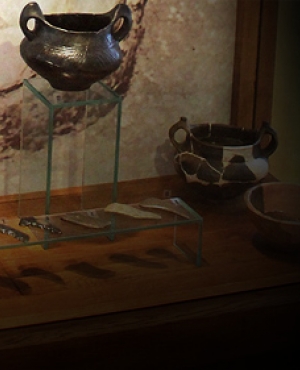
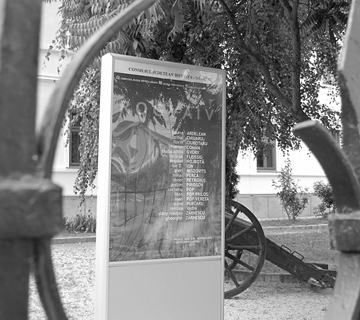 Clipuri Video
Clipuri Video
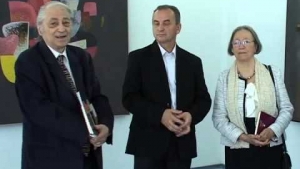
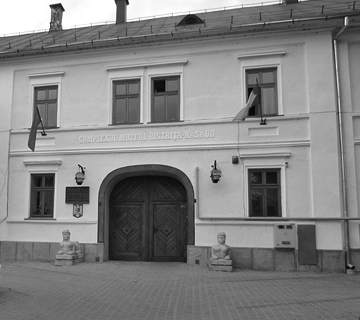 Complexul Muzeal Bistriţa-Năsăud
Complexul Muzeal Bistriţa-Năsăud
